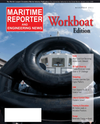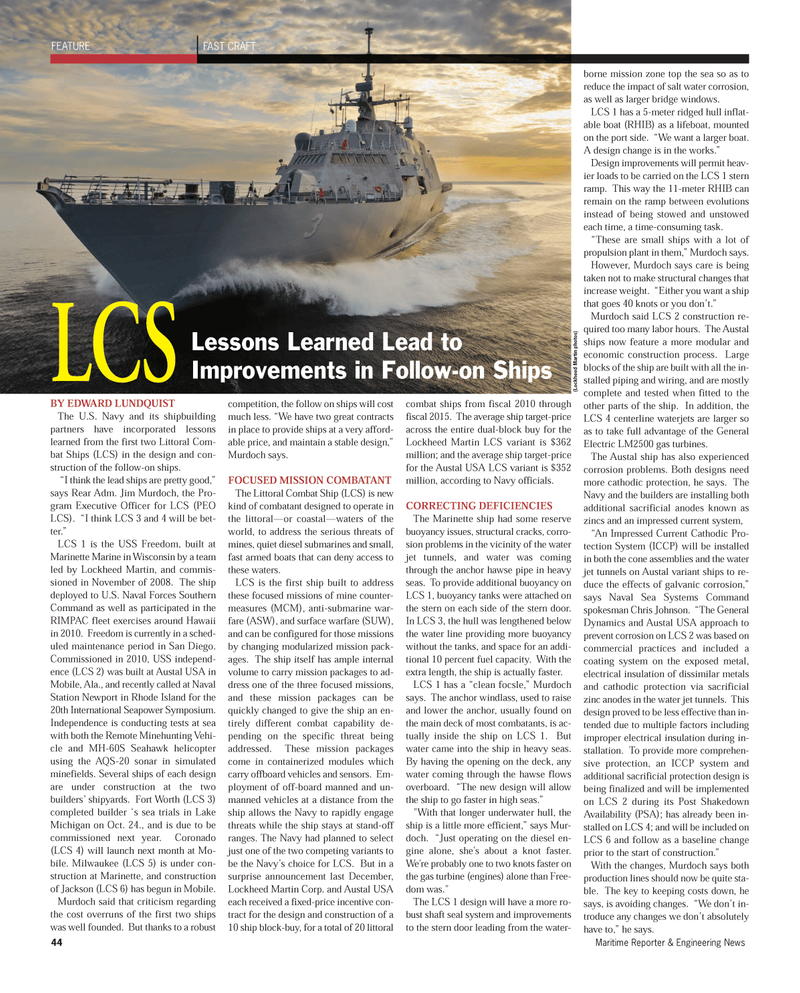
Page 44: of Maritime Reporter Magazine (November 2011)
Feature: Workboat Annual
Read this page in Pdf, Flash or Html5 edition of November 2011 Maritime Reporter Magazine
BY EDWARD LUNDQUIST The U.S. Navy and its shipbuilding partners have incorporated lessons learned from the first two Littoral Com- bat Ships (LCS) in the design and con-struction of the follow-on ships. ?I think the lead ships are pretty good,? says Rear Adm. Jim Murdoch, the Pro- gram Executive Officer for LCS (PEO LCS). ?I think LCS 3 and 4 will be bet-ter.? LCS 1 is the USS Freedom, built at Marinette Marine in Wisconsin by a team led by Lockheed Martin, and commis-sioned in November of 2008. The ship deployed to U.S. Naval Forces Southern Command as well as participated in theRIMPAC fleet exercises around Hawaii in 2010. Freedom is currently in a sched-uled maintenance period in San Diego. Commissioned in 2010, USS independ-ence (LCS 2) was built at Austal USA in Mobile, Ala., and recently called at Naval Station Newport in Rhode Island for the 20th International Seapower Symposium. Independence is conducting tests at seawith both the Remote Minehunting Vehi- cle and MH-60S Seahawk helicopter using the AQS-20 sonar in simulated minefields. Several ships of each design are under construction at the two builders? shipyards. Fort Worth (LCS 3) completed builder ?s sea trials in Lake Michigan on Oct. 24., and is due to be commissioned next year. Coronado (LCS 4) will launch next month at Mo- bile. Milwaukee (LCS 5) is under con- struction at Marinette, and constructionof Jackson (LCS 6) has begun in Mobile. Murdoch said that criticism regarding the cost overruns of the first two ships was well founded. But thanks to a robust competition, the follow on ships will cost much less. ?We have two great contracts in place to provide ships at a very afford- able price, and maintain a stable design,? Murdoch says.FOCUSED MISSION COMBATANT The Littoral Combat Ship (LCS) is new kind of combatant designed to operate inthe littoral?or coastal?waters of theworld, to address the serious threats of mines, quiet diesel submarines and small,fast armed boats that can deny access to these waters. LCS is the first ship built to address these focused missions of mine counter- measures (MCM), anti-submarine war- fare (ASW), and surface warfare (SUW), and can be configured for those missions by changing modularized mission pack-ages. The ship itself has ample internal volume to carry mission packages to ad- dress one of the three focused missions,and these mission packages can bequickly changed to give the ship an en- tirely different combat capability de- pending on the specific threat being addressed. These mission packages come in containerized modules whichcarry offboard vehicles and sensors. Em- ployment of off-board manned and un- manned vehicles at a distance from the ship allows the Navy to rapidly engage threats while the ship stays at stand-off ranges. The Navy had planned to select just one of the two competing variants to be the Navy?s choice for LCS. But in a surprise announcement last December, Lockheed Martin Corp. and Austal USA each received a fixed-price incentive con- tract for the design and construction of a10 ship block-buy, for a total of 20 littoral combat ships from fiscal 2010 through fiscal 2015. The average ship target-price across the entire dual-block buy for the Lockheed Martin LCS variant is $362 million; and the average ship target-price for the Austal USA LCS variant is $352 million, according to Navy officials. CORRECTING DEFICIENCIESThe Marinette ship had some reserve buoyancy issues, structural cracks, corro- sion problems in the vicinity of the water jet tunnels, and water was coming through the anchor hawse pipe in heavy seas. To provide additional buoyancy on LCS 1, buoyancy tanks were attached on the stern on each side of the stern door. In LCS 3, the hull was lengthened below the water line providing more buoyancy without the tanks, and space for an addi-tional 10 percent fuel capacity. With the extra length, the ship is actually faster. LCS 1 has a ?clean focsle,? Murdoch says. The anchor windlass, used to raise and lower the anchor, usually found on the main deck of most combatants, is ac-tually inside the ship on LCS 1. Butwater came into the ship in heavy seas. By having the opening on the deck, any water coming through the hawse flows overboard. ?The new design will allow the ship to go faster in high seas.? "With that longer underwater hull, the ship is a little more efficient,? says Mur- doch. ?Just operating on the diesel en-gine alone, she's about a knot faster. We're probably one to two knots faster on the gas turbine (engines) alone than Free- dom was." The LCS 1 design will have a more ro- bust shaft seal system and improvements to the stern door leading from the water- borne mission zone top the sea so as toreduce the impact of salt water corrosion, as well as larger bridge windows. LCS 1 has a 5-meter ridged hull inflat-able boat (RHIB) as a lifeboat, mountedon the port side. ?We want a larger boat. A design change is in the works.? Design improvements will permit heav- ier loads to be carried on the LCS 1 sternramp. This way the 11-meter RHIB can remain on the ramp between evolutions instead of being stowed and unstowed each time, a time-consuming task.?These are small ships with a lot ofpropulsion plant in them,? Murdoch says. However, Murdoch says care is being taken not to make structural changes that increase weight. ?Either you want a ship that goes 40 knots or you don?t.? Murdoch said LCS 2 construction re-quired too many labor hours. The Austal ships now feature a more modular and economic construction process. Large blocks of the ship are built with all the in- stalled piping and wiring, and are mostlycomplete and tested when fitted to the other parts of the ship. In addition, theLCS 4 centerline waterjets are larger so as to take full advantage of the General Electric LM2500 gas turbines. The Austal ship has also experienced corrosion problems. Both designs needmore cathodic protection, he says. The Navy and the builders are installing both additional sacrificial anodes known as zincs and an impressed current system,?An Impressed Current Cathodic Pro- tection System (ICCP) will be installedin both the cone assemblies and the water jet tunnels on Austal variant ships to re- duce the effects of galvanic corrosion,? says Naval Sea Systems Command spokesman Chris Johnson. ?The General Dynamics and Austal USA approach to prevent corrosion on LCS 2 was based on commercial practices and included acoating system on the exposed metal, electrical insulation of dissimilar metalsand cathodic protection via sacrificial zinc anodes in the water jet tunnels. This design proved to be less effective than in- tended due to multiple factors including improper electrical insulation during in-stallation. To provide more comprehen- sive protection, an ICCP system and additional sacrificial protection design is being finalized and will be implemented on LCS 2 during its Post Shakedown Availability (PSA); has already been in- stalled on LCS 4; and will be included onLCS 6 and follow as a baseline change prior to the start of construction.? With the changes, Murdoch says both production lines should now be quite sta- ble. The key to keeping costs down, he says, is avoiding changes. ?We don?t in- troduce any changes we don?t absolutely have to,? he says. 44Maritime Reporter & Engineering News FEATURE FAST CRAFT LCS Lessons Learned Lead to Improvements in Follow-on Ships (Lockheed Martin photos) MR Nov.11 # 6 (42-49):MR Template 10/28/2011 12:17 PM Page 44

 43
43

 45
45
